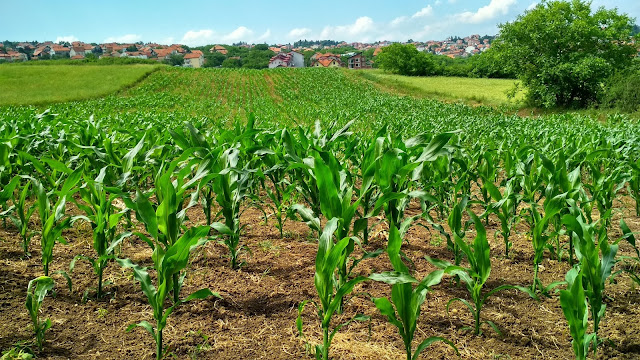A collection of compounding plant growth regulators, compounding with fertilizers, and compounding with fungicides
As a rapidly developing science and technology, plant growth regulators regulating plant growth and development have been used more and more widely in agriculture, forestry, fruit and vegetable production.
In recent decades, the mixture of plant growth regulators has appeared in many applications such as rooting, fruit setting, dwarfing, dormancy, drying, defoliation, ripening, sweetening, and coloring, and the development momentum is rapid.
The reason is that there can be synergistic and additive effects in compound application, which can reduce the amount of use and improve the application effect. At the same time, it also expands the scope of application, complements each other's strengths, overcomes the shortcomings of single use, and can achieve high quality and high yield.
The compounding of commonly used plant growth regulators can be divided into: compounding plant growth regulators, compounding plant growth regulators and fertilizers, compounding plant growth regulators and fungicides, etc.
1. Compounding between plant growth regulators
Previously, everyone thought that plant growth regulators were specific and could not be used in combination. However, modern plant physiology studies have proved that after different plant growth regulators are used in combination, they will produce unexpected good effects.
After using growth promoters and growth inhibitors, it is found that some plants can inhibit vegetative growth and promote reproductive growth. While the plants can control vigorous growth and resist lodging, they can enlarge the fruit, increase yield and improve quality.
1. Sodium nitrophenolate + sodium naphthalene acetate
It is a new type of compound plant growth regulator with labor saving, low cost, high efficiency and high quality. Compound sodium nitrophenolate is a regulator that comprehensively regulates the balance of crop growth, which can comprehensively promote crop growth, and is compounded with sodium naphthalene acetate,
On the one hand, it strengthens the rooting effect of sodium naphthaleneacetate, and on the other hand, it enhances the quick-acting effect of sodium nitrophenolate. Both promote faster rooting effect, more nutrient absorption, more comprehensive, and accelerate the expansion of crops without lodging. , The internodes are stout, with more branches and tillers, disease resistance and lodging resistance.
According to the joint test research of many scientific research institutes, it is shown that the compound sodium nitrophenolate and sodium naphthaleneacetate are compounded in a ratio of 1:3 and applied to rootstocks. The results show that the number of roots is significantly higher than that of sodium naphthaleneacetate alone;
Soybean experiments show that the two significantly promote the thick root system of soybeans, and the ability of rhizobia nitrogen-fixing bacteria is significantly enhanced, showing obvious direct visual effects within 2-3 days;
The test results show that using a 2000-3000 times aqueous solution of sodium nitrophenolate and sodium naphthaleneacetate to spray 2-3 times on the leaf surface of wheat at the rooting stage, the yield can be increased by about 15%, and there is no adverse effect on wheat quality.
2. DA-6 + ethephon (or sodium nitrophenolate + ethephon)
It is a compound type corn special dwarfing, robust, anti-lodging regulator. Ethephon alone has a dwarfing effect, and the leaves are widened, the leaves are dark green, the leaves are upward, and the secondary roots increase, but the phenomenon of premature leaf aging is prone to occur.
The application of DA-6+ethephon compound agent to control the growth of corn, the compound use can reduce the plant by up to 20% compared with the single use of ethephon, which has obvious synergistic effect and anti-premature aging effect.
3. Sodium nitrophenolate + gibberellin
Sodium nitrophenolate and gibberellin are both quick-acting regulators, and both can take effect within a short time after application, so that the crops show good growth effects. Sodium nitrophenolate and gibberellin are used in combination, according to Research on the application of sodium nitrophenolate by the County Jujube Science Institute shows that
While adding the effects of the two, the persistent characteristics of sodium nitrophenolate can make up for this defect of gibberellin, and at the same time, through comprehensive regulation of growth balance, it can avoid the damage to the plant body caused by excessive use of gibberellin. The yield of jujube trees is significantly increased and the quality is also significantly improved.
4. Sodium naphthaleneacetate + indole butyrate
It is the most widely used compound rooting agent in the world. It is widely used in fruit trees, forest trees, vegetables, flowers and some ornamental plants.
The mixture can be absorbed by roots, leaves, and germinated seeds to stimulate the cell division and growth of the inner sheath of the root, so that the lateral roots grow faster and more, improve the plant's ability to absorb nutrients and water, and achieve the overall growth of the plant.
Because the agent often appears synergistic or additive effect in promoting plant cutting rooting, some plants that are difficult to root can also be cut and rooted.
2. Compound plant growth regulator and fertilizer
1, sodium nitrophenolate + urea
sodium nitrophenolate + urea can be described as the "golden partner" in the compounding of regulators and fertilizers.
In terms of effects, the compound sodium nitrophenolate has the characteristics of comprehensively regulating the growth and development of crops, which can make up for the lack of nutrient requirements in the early stage, so that crop nutrition is more comprehensive and urea utilization is more thorough;
In the time of action, the quick-acting and sustained-acting properties of sodium nitrophenolate are combined with the quick-acting properties of urea to make the appearance and internal changes of plants faster and more durable;
In terms of the method of action, the compound sodium nitrophenolate is used in combination with urea, which can be used as a base fertilizer, or as a root spray and fertilization, which can be described as "three birds with one stone".
Compound sodium nitrophenolate and urea-containing foliar fertilizer test, the plant leaves become darker and greenish and shiny within 40 hours after application, and the yield is significantly improved in the later stage.
2. Triacontanol + potassium dihydrogen phosphate
Triacontanol can increase crop photosynthesis. Mixed spraying with potassium dihydrogen phosphate can increase crop yield. The two can be combined with other fertilizers or regulators to apply to the corresponding crops to achieve better results.
such as triacontanol + potassium dihydrogen phosphate + sodium nitrophenolate compound used on soybeans, the yield can be increased by more than 20% compared with the first two.
3, DA-6+trace elements+N, P, K
The compound application of DA-6 with macroelements and trace elements. Hundreds of test data and market feedback information show: DA-6+ trace elements such as zinc sulfate;
DA-6+ a large number of elements such as urea, potassium sulfate, etc., all make fertilizers several times higher than that of single use, and at the same time enhance plant disease resistance and stress resistance.
4, Chlormequat + Boric Acid
The application of this mixture on grapes can overcome the deficiency of Chlormequat. Experiments show that spraying the whole plant with a certain concentration of chlormequat 15 days before the grapes bloom can greatly increase the yield of grapes, but reduce the sugar content in the grape juice.
The mixture can not only play the role of chlormequat in controlling growth and promoting fruit setting and increase yield, but also overcome the side effect of reducing sugar content after using chlormequat.
3. Plant growth regulator + fungicide
1, sodium nitrophenolate + ethyl allicin
The compound use of sodium nitrophenolate and ethyl allicin can significantly improve its efficacy and delay the emergence of drug resistance, and it can resist the phytotoxicity caused by overdose or high toxicity by regulating crop growth, and make up for the losses caused thereby.
Compound sodium nitrophenolate + ethyl allicin EC in the control of cotton fusarium and verticillium wilt experimental research shows that the addition of sodium nitrophenolate reduces the incidence of 18.4% compared with ethyl allicin alone.
and the compound preparation treatment is stronger than the control cotton, the leaves are dark green, and the leaves are thick, and the late decay time is later, and the leaf function period is prolonged.
2. Sodium nitrophenolate + carbendazim
Compound sodium nitrophenolate is mixed with a fungicide to improve the surface activity of the medicine, increase penetration and adhesion, etc., thereby increasing the sterilization effect.
Compound sodium nitrophenolate is used in combination with heterocyclic fungicides, such as carbendazim. In the prevention and control of peanut leaf diseases, two consecutive sprays at the initial stage of the disease increase the control effect by 23% and significantly enhance the bactericidal effect.
3, brassinolide + triadimefon
Brassinolide can promote the germination of crops, trees and seeds, help seedling growth, and improve crop resistance.
According to relevant literature reports: the combination of brassinolide and triadimefon has a combined effect of over 70% in the control of cotton wilt, while promoting the growth of cotton roots and buds. Studies also show that salicylic acid also has a significant synergistic effect on triadimefon.
If you have any interest on Plant growth regulators, please feel free to contact us:
Email:anne@cyclebioscience.com
Whatsapp:+86 15050351426
www.cyclebioscience.com










评论
发表评论